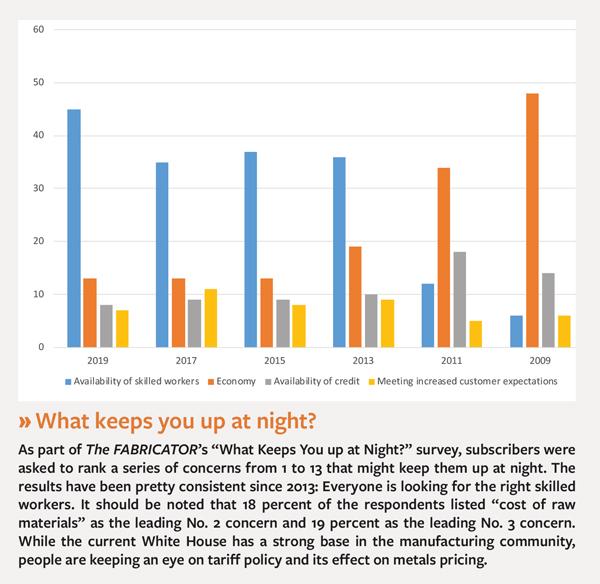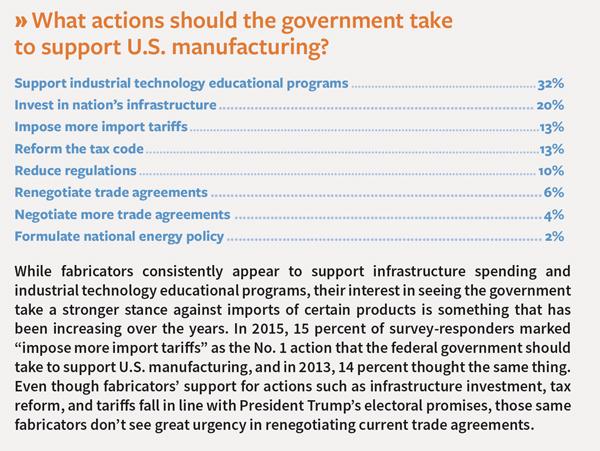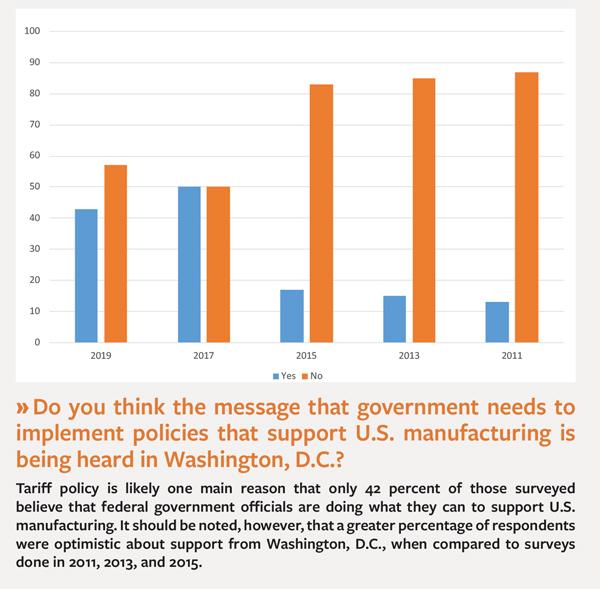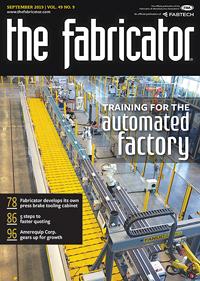Editor-in-Chief
- FMA
- The Fabricator
- FABTECH
- Canadian Metalworking
Categories
- Additive Manufacturing
- Aluminum Welding
- Arc Welding
- Assembly and Joining
- Automation and Robotics
- Bending and Forming
- Consumables
- Cutting and Weld Prep
- Electric Vehicles
- En Español
- Finishing
- Hydroforming
- Laser Cutting
- Laser Welding
- Machining
- Manufacturing Software
- Materials Handling
- Metals/Materials
- Oxyfuel Cutting
- Plasma Cutting
- Power Tools
- Punching and Other Holemaking
- Roll Forming
- Safety
- Sawing
- Shearing
- Shop Management
- Testing and Measuring
- Tube and Pipe Fabrication
- Tube and Pipe Production
- Waterjet Cutting
Industry Directory
Webcasts
Podcasts
FAB 40
Advertise
Subscribe
Account Login
Search
Where's the next generation of fabricators?
In The FABRICATOR’s 2019 "What Keeps You up at Night?" survey, fabrication companies worry about the availability of skilled workers
- By Dan Davis
- September 9, 2019
- Article
- Shop Management

This year's What Keeps You up at Night? survey reveals a record number of fabricators listing 'finding skilled workers' as their No. 1 concern. Getty Images
Peace of mind is a luxury not too many metal fabricators have. In the world of low-volume, high-mix manufacturing, a new challenge is always around the corner—particularly over the past 10 years. The manufacturing economy has been humming along since digging out of the depths of the Great Recession. Meanwhile, manufacturers still are in search of people to help them to grow right along with the economy.
That’s what the 2019 edition of The FABRICATOR’s “What Keeps You up at Night?” survey found. Almost 100 fabricators shared their thoughts with us in a survey that was sent to the subscriber base in June. When asked to rank their No. 1 concern among a list of items (availability of credit, availability of skilled workers, consolidation of competition and customers, cost of raw materials, economy, erosion of manufacturing as a viable career choice, foreign competition, government regulations/policy/tariffs, growth of federal government debt, health care costs, lack of business strategy, meeting increased customer expectations, and other), 45 percent listed “availability of skilled workers,” the highest percentage since this issue started dominating this survey question in 2011.
Their response should come as no surprise, particularly in recent years. The unemployment rate sits at historic lows at 3.7 percent as of the Bureau of Labor Statistics’ June report. In 2018 the manufacturing sector created about 22,000 jobs per month, according to U.S. Department of Labor data. This has slowed to about 8,000 new jobs per month in 2019, but it’s still been a robust expansion of the manufacturing economy since 2009.
After all, the U.S. is officially in its longest economic expansion ever, which started in June 2009. The previous record of 120 months of economic growth took place from March 1991 to March 2001, according to the National Bureau of Economic Research.
Many recognize that this economic recovery has been marked by sluggish GDP growth, but even this less-than-robust recovery has been good for manufacturers as they have added jobs, building up the manufacturing workforce to 2009 levels. The BLS counted 12.6 million manufacturing workers in the U.S. in January 2009 and 12.9 million workers in June 2019.
If manufacturers are adding jobs, that’s a sign of a prosperous manufacturing economy. To keep up with those opportunities, many shops have relied on investments in new automation, looking to decrease the need for labor. In this “What Keeps You up at Night?” survey, 48 percent of survey respondents indicated they planned to invest in more automation in the coming 12 months, up slightly from 45 percent in 2017. In the 2019 survey, 32 percent said their companies planned to invest in new laser cutting machines, and 28 percent said they were looking at new press brake equipment. Twenty-five percent were considering robotic welding equipment, hoping to remedy the welding bottleneck that seems to exist for so many fabricating companies.
Why Not Manufacturing?
That still doesn’t address metal fabricators’ concern about finding the right workers for their shops. Sure, more schools are upgrading their vocational skills development facilities, such as building more welding labs, and associations like the Fabricators & Manufacturers Association are trying to boost awareness of manufacturing with young people by sponsoring hands-on manufacturing camps. But it’s still an uphill battle, even in the face of ample opportunities in the manufacturing sector.
In June the Brookings Institution conducted a poll that examined attitudes toward manufacturing. The researchers connected with 2,001 adult internet users. When people were asked how they feel about manufacturing, 58 percent reported that they believe manufacturing is important to the U.S. economy, 14 percent think it is somewhat important, and 6 percent feel that it is not very important. Twenty-two percent said they are unsure.
That sounds promising, but responses differed significantly by age. Seventy-one percent of people over the age of 55 indicated that they view manufacturing as very important, whereas only 45 percent of those aged 18 to 34 years felt the same way.
When the “What Keeps You up at Night?” survey asked fabricators what should be done to boost young people’s awareness of manufacturing, they had some specific ideas:
“Have the government and the schools bring back industrial arts.”
“Better and more emphasis on trades education. Also, funding or tax credits for companies that invest in technology to narrow the gap between the experienced workforce and the entry-level employees’ quality of work and production.”
“More schools involved with sheet metal process training.”
“Federal-level programs for employee training that transcend state lines.”
“All high schools should have an introduction to skilled trades class available sometime during ninth to 12th grade.”
“Revamp of our nation’s education focus, which would need to include a change in our culture so that skilled factory jobs become desirable again for young people.”
“Implementation of a European-style apprenticeship program throughout the U.S.”
In the meantime, fabricators continue their search. Fifty-four percent reported that they were going to devote major resources to finding and retaining skilled labor over the next three to five years. Over the same period of time, however, only 15 percent pledged to establish or offer apprenticeships and internships, and only 13 percent expected to offer technical training for shop floor employees. In the midst of trying to keep up with customer demands, many small to medium-sized companies struggle to find the time and resources to tackle employee training.
Despite the concerns, a majority of fabricators revealed that they are resting easy considering what is going on around them. Sixty-one percent reported that their businesses are growing, and 74 percent said that they were satisfied about their situation working in metal fabricating. They may not be able to control the public’s perception about manufacturing or national trade policy, but metal fabricators are maintaining a positive attitude about their immediate futures.
Thanks for Participating!
The 2019 “What Keeps You up at Night?” survey was sent to approximately 17,000 email addresses in June. About 100 surveys were returned.
The FABRICATOR staff selected four survey respondents to receive $50 gift cards as a reward for participating in the survey. The winners were:
Joe Schueler, West Falls, N.Y.
Samuel Buck, Westville, N.J.
Josh Bohman, Marshfield, Wis.
Brad Hendrickson, Mendota, Minn.
About the Author

Dan Davis
2135 Point Blvd.
Elgin, IL 60123
815-227-8281
Dan Davis is editor-in-chief of The Fabricator, the industry's most widely circulated metal fabricating magazine, and its sister publications, The Tube & Pipe Journal and The Welder. He has been with the publications since April 2002.
subscribe now

The Fabricator is North America's leading magazine for the metal forming and fabricating industry. The magazine delivers the news, technical articles, and case histories that enable fabricators to do their jobs more efficiently. The Fabricator has served the industry since 1970.
start your free subscription- Stay connected from anywhere

Easily access valuable industry resources now with full access to the digital edition of The Fabricator.

Easily access valuable industry resources now with full access to the digital edition of The Welder.

Easily access valuable industry resources now with full access to the digital edition of The Tube and Pipe Journal.
- Podcasting
- Podcast:
- The Fabricator Podcast
- Published:
- 04/16/2024
- Running Time:
- 63:29
In this episode of The Fabricator Podcast, Caleb Chamberlain, co-founder and CEO of OSH Cut, discusses his company’s...
- Trending Articles
How to set a press brake backgauge manually

Capturing, recording equipment inspection data for FMEA

Tips for creating sheet metal tubes with perforations

Are two heads better than one in fiber laser cutting?

Hypertherm Associates implements Rapyuta Robotics AMRs in warehouse

- Industry Events
16th Annual Safety Conference
- April 30 - May 1, 2024
- Elgin,
Pipe and Tube Conference
- May 21 - 22, 2024
- Omaha, NE
World-Class Roll Forming Workshop
- June 5 - 6, 2024
- Louisville, KY
Advanced Laser Application Workshop
- June 25 - 27, 2024
- Novi, MI





























